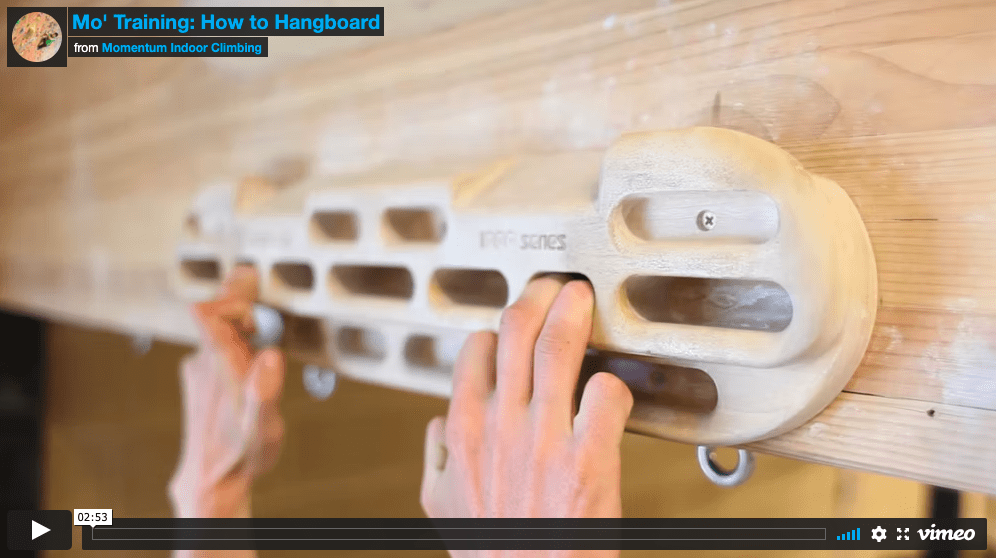Jon Vickers /
Climbing is unlike any other sport in that it emphasises finger strength in such a dramatic way. Not only do we need finger strength to simply hold on to the rock, but it drastically changes our ability to pull to the next hold. Even if you have the strongest biceps in the world, it doesn’t really matter if you can’t maintain a strong hand position. Sometimes referred to as ‘contact strength,’ finger strength dictates what holds you can hang on, what directions you can use them and even how hard you can pull.
Just like with many types of training, you must perform a cycle of overload, recovery and supercompensation to increase finger strength. However, finger training is slightly different from other types of strength training due to the way we use our hands for climbing. Generally, once a hold is gripped properly, there is very little motion within the hand. While our arms and legs perform various types of movements, our hand positions remain relatively fixed by comparison. In pursuit of specificity, most finger training does not consist of movement but instead is what is referred to as ‘isometric’ exercises.
Isometric contractions happen when the muscle’s length remains fixed and does not shorten or lengthen during the contraction. By comparison, concentric contractions happen as the muscle is shortening and eccentric contractions happen as the muscle lengthens. This an important distinction because according to The Climber’s Training Manual, clinical data has shown isometric training to be superior for training strength at specific joint angles. The good news is that joint angles and grip positions are easy to replicate on a hangboard. Just make sure to account for the fact that isometric strength gains only affect the strength of a particular joint within about 15 degrees of the training angle. You will have to train various joint angles to increase your finger strength across a multitude of hold types.
Hangboard Routines and Protocols
“Repeaters are the only hangs I do” will say one friend, “max hangs are the best use of your time” will say another. Then some beastly climber will weigh in with “1-arm hangs are the fastest way to get real strong!” The fact is, there are tons of hangboard routines out there and if you commit to one, chances are your fingers will get stronger.
Of course, some are informed by well supported research and others are not. This is not to say that any particular hangboard protocol is bad, but it is important to know that many of the programs you may come across have very little research to support them. Steve Maisch gives a great summary of the research in regards to isometric training on his blog, but he warns that most research is not climbing or even finger strength specific.
Despite this limited research, many routines have been distilled from time tested methods and most systematic approaches to finger training yield some level of results. The multitude of finger training approaches includes fingerboard pyramids, max hangs, repeaters, encores and many more. In this article we will highlight the general ways to perform two of the more popular protocols: repeaters and max hangs.
What Are Max Hangs?
This very simple approach to hangboarding has been popular for increasing finger strength for a long time. Often referred to as dead hangs or max hangs, this protocol is characterized by single hangs of a short durations, followed by a considerable amount of rest. The resistance is usually adjusted by changing weight, reducing hold size or increasing number of sets. Generally, the goal hang time is held at a constant.
For the most part, max hangs are done for somewhere between 3 and 10 seconds and the rest between repetitions is about 2 or 3 minutes. Given the very specific intensity that is required to achieve failure in such a short hang, it is common to either add or subtract weight when using specific holds. Some expert climbers have resorted to 1-arm hangs to avoid adding large amounts of weight, while others add and/or remove weight from themselves to utilize a more balanced and comfortable two handed hang. Some recent studies, such as Eva Lopez’s 2012 study, suggest that using added weight and therefore training on larger edges may produce better results than using miserably small edges with less weight.
Max Hangs
3 to 10 second hang
1 hang per set
2 to 6 sets
2 to 3 minutes rest between sets/hangs
*Note: Many variations of this type of routine exist. This is a very simple version that is easy to follow.
What Are Repeaters?
Repeaters are a fingerboard routine where you repeatedly perform the same hang in quick succession with very little rest. Since the Rock Climber’s Training Manual’s publication in 2014, this routine seems to be establishing itself as the standard for finger training. More and more people have been introduced to this protocol and its appeal is three-fold. It is simple to follow, it is relatively safe on the fingers and many of the routine’s components are supported by (limited) research on isometric contractions– these components being the time spent hanging, time spent resting and the number of repetitions.
This type of hangboard routine, which has been outlined by many, is a series of hangs of a fixed amount of time with a fixed amount of rest between. The times suggested by the Anderson’s are cycles of 10 second hangs with 5 second of rests for beginners, and 7 second hangs with 3 seconds of rest for intermediate climbers. Both of these routines are done with 6 to 7 repetitions. Their proposed advanced routine differs slightly from this, but still uses the 7 to 3 ratio for timing.
Repeaters
7 to 10 second hangs alternating with 3 to 5 second rests
6 to 7 hangs per set
2 to 3 sets
2 to 3 minutes rest between sets
*Note: Many variations of this type of routine exist. This is a simplistic design similar to the repeater routine outlined in The Rock Climber’s Training Manual.
Hangboarding Considerations
Once you have decided whether or not you plan to do max hangs or repeaters, you must pick your grips and have a plan to adjust your resistance incrementally. This can pose some challenges for someone new to hangboarding because there are lots of options available and getting a good routine developed can take some trial and error. Be willing to take a few sessions to dial in your system and take note of how your performance changes based on rest, warmup and other factors. Remember the most important thing during a hangboard phase is hangboarding so if you use bouldering to warm up, make sure you stop before your tax yourself too much to complete your hanging routine.
It can be hard to find a good balance between climbing and hangboarding and often hangboarding must be prioritized to see consistent gains. Even the order of grips trained in a session can drastically alter your success. The sequence of the holds should help you warm up, while also allowing you to prioritize specific holds. Finding the correct balance between a diverse set of grips and too many grips is crucial. It is generally better to choose fewer holds, but make certain they are the best hold types for the climbing you are training for. The holds on a steep Maple Canyon route are very different than a nearly vertical wall in American Fork Canyon.
Some General Guidelines for Hold Selection
Choose between 3 and 8 grip positions to train.
Choose holds similar to ones you are plan to climb on (size, depth, incut)
Train on ergonomic holds that are comfortable.
Sequence the hold order for warming up and to prioritize key grips.
Consider alternating between similar grip types
Hangboarding is pretty intense. This kind of focused finger training is both super beneficial and inherently dangerous for our fingers. It is important to remember that one workout, set or rep is never worth suffering a debilitating finger injury. Listen to your body, warm up properly and try hard when you are well rested. If you ever experience something that feels weird or painful, don’t discount it. It may be worth it finish a session early or take an extra rest day if your fingers are in pain. Remember strength gains are best achieved when you are well rested and can perform near your max. As you become stronger and stronger, making sure to continually increase the intensity is key to seeing gains, but make sure to do this carefully. Finger injuries will set you back and are never worth it.
Some Hangboard Routines
Max Hang: Steve Maisch’s Protocol
Repeaters: The Rock Climber’s Training Manual
Works Cited and Further Reading:
The Self Coached Climber by Dan Hague and Douglas Hunter
The Rock Climber’s Training Manual by Michael and Mark Anderson
Training for the New Alpinism by Steve House and Scott Johnston
Performance Rock Climbing by Dale Goddard and Udo Neuman
A Novel Tool and Training Methodology For Improving Finger Strength in Rock Climbers by Michael and Mark Anderson (This is some deep reading for the nerds!)
Our next article:
Strength Part lll: Sport Specific Lifting for Climbing



One Comment